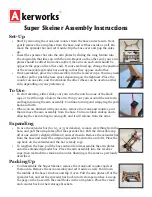
The chain stitch is formed using two threads, one thread in the needle and one thread in the chain looper.
Chain Stitching looks like a straight stitch on the top of the fabric while the chain looper thread forms a chain
on the underside of the fabric. The chain stitch has stretchability that is not found in the conventional locked
straight stitch from a sewing machine. The chain stitch is used to stabilize seams in woven fabrics and where
needed in knit fabrics. The chain stitch can also be used for sewing wide elastic in garments and applying
bias tape.
For Chain Stitch:
1. Turn the cutting blade to the locked position.
2. Disengage the upper looper by turning the upper looper positioning lever to the "down" position.
3. Place the machine in threading position to thread the chain looper (page 19)..
4. Follow the diagram to thread the chain looper. Open side cover of machine to make sure the thread is
through the eye of the chain looper. Trim thread to 4 inches (10cm) and lay in tray.
5. Follow the guide to thread the chain/cover stitch needle, (C-1, C-2, or C-3). Place needle thread on top
and to the left of presser foot before sewing.
6. Set stitch length and other machine adjustments (chart below).
7.
Engage the threading lever in serging position.
8. Remove the blade cover and attach sewing table (page 10).
9. Place the fabric under the needle and turn handwheel toward you two or three stitches in the fabric. Cut
the excess threads and start sewing.
Note:
All chain and cover stitches must be started with fabric under the needle.
CHAIN STITCH
C
H
A
I
N
/
C
O
V
E
R
S
T
I
T
C
H
E
X
P
R
E
S
S
44
Chain Stitching
NEEDLES
C-1,C-2 or C-3
LENGTH
2.5 - 4.0
Set Needle Tension
Dial to:
4-6
Set Chain Looper
Tension Dial to:
Chain Stitch
〈
〉
Содержание Evolution BLE8W-2
Страница 1: ......
Страница 19: ...17 Notes ...
Страница 77: ...T E C H N I Q U E S 75 Notes ...
Страница 92: ...90 BLE8W 2 TA EI 33 2 E 2009 6 1500 ...
















































